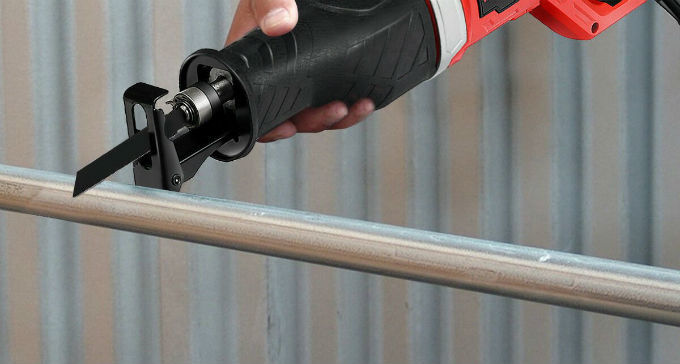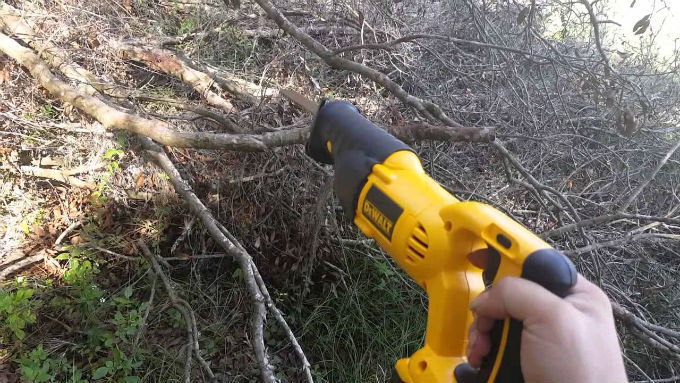
Just what can you cut with a reciprocating saw? A lot, it turns out – this handy tool, combined with the right blade, can cut through just about anything just short of rocks or solid metal.
A reciprocating saw is an ideal demolition tool, able to cut down studs, the nails in the studs, and the drywall attached to it. It can also chow down on metal pipes and even solid rebar with the right blade, too.
The cutting capabilities of a reciprocating saw are highly dependent on the blade. So the question of whether you can cut into something with this tool mostly boils down to – do you have the blade for it?
With the proper blade, the reciprocating saw is a safe way to make rough cuts in a wide array of materials, more so than rotary cutting tools like circular blades or angle grinders.
Can You Cut Aluminum with a Reciprocating Saw?
If you have the right metal-cutting blade for it, yes you can cut through aluminum with a reciprocating saw. A metal cutting blade with a fine tooth pattern will cut through aluminum doorway thresholds with little problems.
If you are working with thicker metal sheets, a bit of lubricant or WD-40 can help cool down the blade and stop the aluminum from welding to it.
Alternatively, you can keep the saw speed on the lower side to help keep the blade from heating up too much. A bimetal or carbide coated metal-cutting blade will also last longer if you are working on aluminum a lot, too.
Can you Cut Brick with a Reciprocating Saw?
Reciprocating saws can cut through brick and mortar, as well. You will need a blade specially designed for cutting through brick and concrete first, though.
These blades are extra aggressive, with a very low teeth count – around 2 teeth per inch is the norm for these types of masonry blades. Diamond/carbide blades will also work.
TIP!
While it is POSSIBLE to cut through brick with a reciprocating saw and the right blade, other tools are much better suited for the task. Angle grinders and circular saws are much more efficient for this type of material.
The teeth are shaped differently, too, with extra-wide spacing between the elongated teeth to make sure that the blade does not get choked on dust and debris.
Do keep in mind that your blade needs to be longer by at least 2 inches than the brick piece you are cutting into for the reciprocating blade to work.
Always wear eye protection when cutting into brick and mortar, to protect your eyes from shards of material sent flying by the reciprocating saw. A dust mask is highly recommended too.
Can You Cut Cast Iron with a Reciprocating Saw?
You can cut cast iron with a reciprocating saw, as well as just about any type of iron piping that’s not too large for the tool.
To cut into a cast iron pipe or bar, you can use a metal cutting blade, or a carbide coated blade to do the job if you are willing to use up and change blades in the middle of a task.
The best way to cut cast iron with a reciprocating saw, however, is with a diamond grit blade, especially the ones designed for cutting into the material.
Diamond reciprocating blades can cost more than 5 times the usual saw blade, but they are worth it if you are cutting into a lot of cast iron.
Diamond blades do not dull in one cut, and they are easier to handle compared to using a toothed blade as well.
Plus, they are still much cheaper than using a diamond grinder blade, so it’s definitely something to consider if you’re on a budget.
Can You Cut Concrete with a Reciprocating Saw?
You can cut through concrete with a reciprocating saw, as long as it’s a piece that’s thin enough for the tool, which is usually never the case with concrete.
It is not recommended to cut concrete with a reciprocating saw, instead use a circular saw or angle grinder with a diamond blade attached.
Can You Cut Curves With a Reciprocating Saw?
You can cut curves with a reciprocating saw, as long as you’re not looking for a highly finished result.
Thinner blades, as well as flexible, longer blades, will let you do freehand curves with a reciprocating saw to an extent.
You can also use a template for making larger, rough circular cuts as well, by keeping the shoe of the tool pressed against the material and next to the template.
Can You Cut Drywall with a Reciprocating Saw?
You can cut drywall with a reciprocating saw very easily, using just the general-purpose blades your tool may already come with out of the box. The bigger teeth you have on the blade, the faster you can cut or demolish drywall, too.
You can also make plunge cuts in dry wall with a reciprocating saw. To start a cut, check that you have a pointed blade attached to your tool. Rest the shoe of the saw along the cutting line, with the tip of the blade over the material. Turn on the saw, and use the shoe as a pivot as you press the running blade tip into the drywall to start the cut.
Can You Cut Metal with a Reciprocating Saw?
You can cut metal with a reciprocating saw if you have the right metal-cutting blade attached. Even if you just have a demolishing blade on your tool, that’s already plenty to cut nails, screws and other fasteners, too.
Always wear eye protection when using a reciprocating saw on metal and nails.
Can You Cut Plywood with a Reciprocating Saw?
You can cut plywood with a reciprocating saw, and rather easily, too – as long as you don’t mind the jagged edges.
A general-purpose reciprocating blade is more than capable of tearing through plywood, and a demolishing blade will eat through the supporting lumber and nails, as well.
To get a cleaner cut with your reciprocating saw, it helps if you have a way to guide your tool. You can use the edge of an existing framing or door jamb to help guide your cut, or you can take the time to mount a guide fence or a straight edge that you can follow with the shoe of the reciprocating saw.
That said, consider that there are better tools out there for making a clean cut on plywood.
Can You Cut PVC with a Reciprocating Saw?
You can easily cut through PVC pipes with a reciprocating saw, and you will not even need a special blade to do it. A woodworking or demolition blade is plenty for cutting through PVC pipes, as long as you can secure it in place.
To make cutting PVC pipes go faster, try to hold the shoe against the pipe as you make the cut.
Can You Cut Rebar with a Reciprocating Saw?
You can cut rebar with a reciprocating saw, and much faster too compared to using a hacksaw. And just like a hacksaw, you will need a suitable blade for cutting rebar – one with fine, sharp teeth of the right size.
Any reciprocating blade marked suitable for mild steel will also work just as well.
You don’t need to cut all the way through the rebar to finish the cut. Once you have cut the piece almost all the way, you can bend and snap it off to get the piece you want. Keep in mind to always wear eye protection when using power tools to cut rebar.
Can You Cut Small Trees with a Reciprocating Saw?
You can cut small trees with a reciprocating saw, and by small trees, we mean those around 5 inches in diameter at the most.
To cut into wet, green lumber, you will need a pruning blade that will not get caught in the fresh fibers of the tree. Pruning blades come with extra aggressive teeth with extra-long gullets spaced evenly throughout the blade, which lets them cut through green wood without choking.
Make sure to always be in control of the direction where the tree will fall. It’s also best to avoid cutting trees on windy days.
Can You Cut Steel with a Reciprocating Saw?
You can cut steel with a reciprocating saw, and not just mild steel, too. For cutting into mild steel and rebar, you can use a metal-cutting blade or a bimetal blade and get good results out of those.
Once you start dealing with hardened steel, stainless steel or boron steel, though, you may need to invest in carbide tipped blades. Finer blades with 8 teeth per inch (TPI) will give you faster results.
Diamond grit blades work well and last longer, and these can give you cleaner results too - if you don’t mind the initial expense and the slower cutting speed.
For cutting smaller steel pipes, you can get faster results by holding the shoe of the reciprocating saw against the pipe as you make the cut.
You can also rock the saw up and down to speed up the process as well. Keep in mind to always wear eye protection whenever you cut steel with a reciprocating saw.
Can You Cut Tile with a Reciprocating Saw?
You can cut tile with a reciprocating saw if you’re not planning to use them afterwards (demo).
A reciprocating saw with an abrasive grit blade will make short work of ceramic tile, stone, and the mortar behind them, which will significantly speed up your kitchen or bathroom demolition job.
There are also attachments made for reciprocating saws that let you rip off old ceramic and vinyl tiles off the walls.
They come in the form of wide chisels, and they take advantage of the high back and forth speed of the reciprocating saw to quickly dig and rip out the tile adhesive from under existing tiles.
Can You Cut Tree Limbs With a Reciprocating Saw?
You can cut tree limbs with a reciprocating saw – in fact, it’s one of the safest and fastest ways to prune a mature tree of some of its larger branches.
That said, a reciprocating saw will be able to prune a limb that’s 5 inches in diameter at the most. Any more than that and you may be better off with a small chainsaw to do the job.
To cut through fresh wood, a general-purpose reciprocating blade can do the job. You will be better served by a pruning blade, though, especially if you will be pruning several trees on the property.
For outdoor work, a cordless reciprocating saw will give you the much needed portability for the task.
Always wear eye protection when pruning trees with a power tool, especially with a reciprocating saw. The short blade of the tool means that you will be working close to the action, and you will be making a lot of overhead cuts too.
Can You Cut Wood with a Reciprocating Saw?
Yes, you can cut wood with a reciprocating saw, along with a wide variety of materials. You can cut through plywood and plyboard with no problem using just a general purpose blade with your tool. You can also cut dimensional lumber and studs, too, along with the nails and screws.
Aside from construction wood, you can also cut firewood with a reciprocating saw. A reciprocating saw blade with large, sharp teeth and wide gullets will easily cut through seasoned or even relatively fresh firewood, even if it comes with knots.
A bimetal or carbide coated blade will give you faster results if you are dealing with a lot of hardwood, as well. Plus, they will last a bit longer, which means less downtime changing blades, too.




